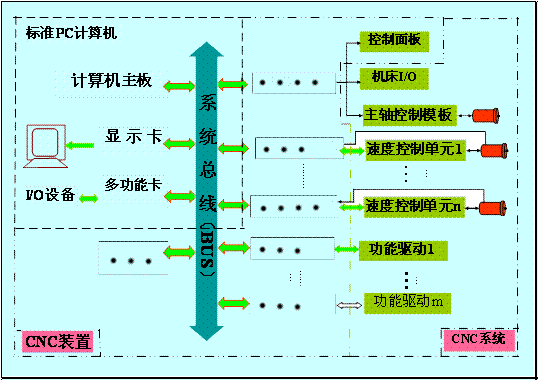CNC device hardware architecture (Figure)
I. Overview
From the perspective of its hardware composition, the CNC device can be divided into the following categories according to how much CPU it contains:
Stand-alone system: The entire CNC device has only one CPU, which centrally controls and manages the entire system resources, and implements various NC functions through time-sharing processing.
Master-slave structure, there is only one CPU in the system (called the main CPU). It has control and usage rights to the resources of the system. Other functions with CPU can only accept the control commands or data of the main CPU, or send request information to the main CPU. Get the data you need. That is, it is in a subordinate position, so it is called a master-slave structure.
Multi-machine system: There are two or more CPUs in the CNC device. Some function modules in the system also have a CPU. According to the mutual relationship between the components, they can be divided into:
Multi-master structure: There are two or more module components with CPU in the system that have control or use rights to system resources. The modules are tightly coupled, have a centralized operating system, solve the bus contention problem through the arbiter, and exchange information through the common memory.
Distributed structure: The system has two or more functional modules with CPU. Each module has its own independent operating environment. The modules are loosely coupled and communicated by communication.
Second, the function of the single machine or master-slave structure module
The CNC device is constructed in a modular design
Modular design method: The control system is divided into several unit modules with independent functions according to functions, and equipped with corresponding driver software. When the system is designed, different functional modules are selected according to the requirements of the function, and they are inserted into the motherboard of the control unit to form a complete control system. The unit motherboard is generally a passive mother board of a bus structure, which provides a signal path for interconnection between modules.
The condition for implementing the modular design of the CNC system is the standardization of the bus (BUS). When using a modular structure, the design of the CNC system can be attributed to the rational selection of functional modules.

1, computer motherboard and system bus (motherboard)
The computer motherboard is the core of the CNC device.
Functional structure:
CPU and its peripheral chips; memory unit and its peripheral chips; communication interface (serial port, parallel port, keyboard interface). Soft and hard drive interface.
The main role of the computer motherboard:
Performs arithmetic and logic operations on various data, information (part processing programs, various I/O information, etc.) input to the CNC device. According to the processing result, a control command is sent to each functional module to transmit data, so that the user's instruction can be executed.
System bus (motherboard): consists of a set of physical wires that carry digital information. It is the channel through which data or information is exchanged within a computer system:
Data bus: 8 data lines, bus width 8 bits; address bus: 16 address lines (direct addressing 64k);
Control bus:
The bus master of an industrial PC is an independent passive four-layer board (traming surface, component surface, power plane, and ground plane), which is more reliable than two layers. The specifications are 6 slots, 8 slots, 12 slots, 14 slots, and the like.
Next page
Crimped Wire Mesh,Wire Mesh,Woven Mesh
Corner Bead,Plaster Mesh Co., Ltd. , http://www.chcornerbead.com